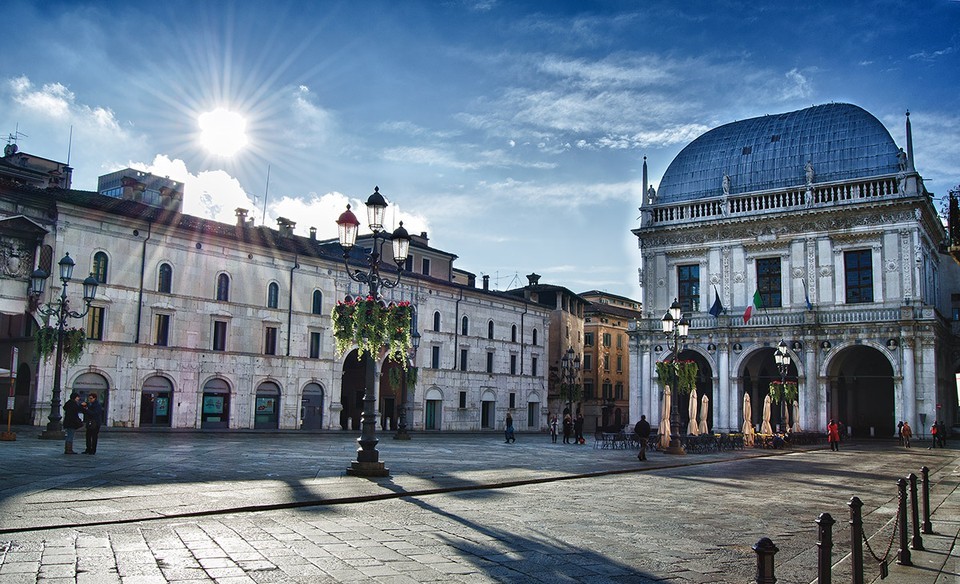Let’s openly state that Brescia is not as unknown as we believe, but people should only appreciate its soul so pulsating which aims at/to internationality. After all, Brescia was the birthplace of pope Paul VI, who was known as the pope of artists. Furthermore, it is the city of engines, famous for “La Freccia Rossa”, and the Mille Miglia Race, which Enzo Ferrari claimed to be “the most beautiful race in the world”.
The Roman Forum
Squares have always represented the symbol and image of a community, and Brescia can boast four of them. Their assets became rich in heritage, as is still visible in the town’s urban outlines. The first model of square was the Roman Forum, where people discussed their political and economic matters.
In 1823, the municipality of Brescia, together with the local Athenaeum, started an archaeological excavation which was resumed and interrupted in several phases. An astonishing finding during this process was the Capitoline temple at the foot of the Cidneo hill. At first, this temple was probably closed along all four sides. The building was collocated right in the middle of the major axes of the city “the cardo and the decumanus maximus”. A short walk allows visitors to understand the monumental layout, and the dedication on the pediment of the templeespecially highlights the magnificence of the city from Imperial Roman times to the decadence of the empire. Within the Roman area, the town boasted a basilica, a curia and, even a theatre which is still a unique architectural piece and among the best preserved in northern Italy.
The medieval square
With the saying “One thousand and no more thousand” the phenomenon of urbanization flourished throughout Europe and also involved Brescia. More space was needed, which resulted in the Roman Forum being abandoned in favour of Piazza Duomo. Later on, the name of this place became “Piazza Paolo VI” in honour of the Pope Giovanni Battista Montini.
This medieval square became both a useful centre of Christianity and a suitable place for local commerce as it was close to the old town hall, also known as “the Broletto”. Next to this building there was bell tower, known as the “Torre del Pegol” near two important cathedrals.
Below the bell tower, the merchants traded their wares, while the two churches represented a strong religious point of reference for the inhabitants. Nowadays, the Duomo Vecchio, also known as the “Rotonda” due to its circular shape, still holds medieval style masses. The other holy temple is the Duomo Nuovo, which was later demolished and rebuilt in the late Baroque style.
The Renaissance square
Piazza Loggia is a Renaissance square. It was conceived and built in the Venetian style, or “a Platea Granda”. This new space was commissioned by the Podestà Marco Foscari as a hegemonic symbol of the Venetian Republic: in fact, Brescia orbited around the Venetian Zenit for over four centuries.
This beautiful site is enclosed between palaces and porches. The main building is the Loggia, which is the seat of the city’s municipal administration to this day. On the opposite side of the square there are arcades with the clock tower (1540-1550) and, on the top tower, two mechanical figures (automi robot) that mark the time with their hammers and are affectionately called “I matti delle ore” (the madmen of the hours) by the inhabitants. The Notarial Palace, along with its original staircase which connected the palaces, is also noteworthy. Next to the loggia it is possible to admire the old and new “mounts of piety” (Renaissance institutional pawnbrokers).
Victory Square
South of Piazza Loggia lied an area with a high commercial vocation, where the grain and fish market districts were located. Because it was considered a threat to the health and hygiene of the population, it was destroyed at the beginning of the XX century. Subsequently, a new town plan was drawn and entailed the improvement of the areaby means of urban evisceration . In addition to this, the new map laid out the construction of new and modern buildings.
The supervisor of the building site was Marcello Piacentini, the architect of the Fascist Party. Due to his intervention many important traces of the medieval substratum, such as the Curia Ducis, better known as the “Cordusio”, were lost and incorporated into the modern part of the city. Fortunately, not everything was destroyed and lost: the “arengario pulpit” (1932) made of rose marble (from Tolmezzo), which depicts the historical and decisive facts of Brescia, was spared.. At the end of this urban extension, the square was rebuilt in the Rationalist style and ultimately included the “Palazzo delle Poste”. As soon as the new square was ready, it was called “Vittoria” in memory of the Italian mission during the First World War.

